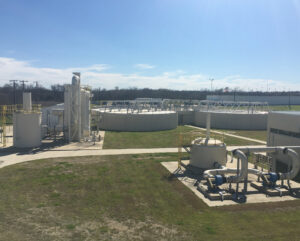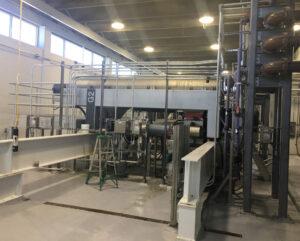The City of Garland, Texas, provides wastewater services to over 320,000 customers in a large residential area north of Dallas. Like many wastewater service providers in the region, Garland is dealing with a rapid growth in population and urban density. The increased demand has required major renovations to its wastewater treatment plants, both to increase their capacity and to cut down on unpleasant odors from preventing development around the treatment plants.
In this interview, Malcolm Parker, the superintendent of Garland’s Rowlett Creek Wastewater Treatment Plant, speaks with Municipal Water Leader about the process of revamping the plant and how it led to a National Association of Clean Water Agencies (NACWA) award.
Municipal Water Leader: Please tell us about your background and how you came to be in your current position.
Malcolm Parker: I started with the City of Garland in wastewater treatment in July 1986. The City of Garland has two wastewater treatment plants, Rowlett Creek Wastewater Treatment Plant and Duck Creek Water Treatment Plant. I started at Duck Creek and worked there for 6 months as a wastewater operator. Then I was transferred to the Rowlett Creek plant and have been here for going on 34 years.
Municipal Water Leader: Please tell us about the City of Garland’s water and wastewater services.
Malcolm Parker: As I mentioned, we currently have two wastewater treatment plants, Rowlett Creek and Duck Creek. The Rowlett Creek plant’s design capacity is 24 million gallons a day (MGD), and Duck Creek is a 40 MGD plant. Between the two plants, we employ about 60 people. Our customer base is well over 320,000 people. We serve the cities of Garland, Rowlett, Sachse, and portions of Dallas, Richardson, and Sunnyvale. That puts our service area at over 100 square miles.
Municipal Water Leader: Please tell us about the history of the Rowlett Creek Wastewater Treatment Plant.
Malcolm Parker: The Rowlett Creek plant was built in 1952. At that time, it was a trickling-filter activated-sludge plant. Over the past 70 years, it has undergone three major expansions. In 1952, the plant was rated for 2 MGD. The first expansion took place in 1956, when the contact stabilization basin, which is an activated-sludge unit, was added. In 1983, a major expansion upgraded the plant to 16 MGD. Then into the early to mid-1990s, a third expansion upgraded the plant to 24 MGD. At that time, it was a trickling-filter activated-sludge plant with anaerobic digesters along with a belt filter press for processing the sludge. In 2015, we started a project to improve our handing of solids by converting the digesters to solids holding tanks and replacing the belt presses with centrifuges as well as adding odor control features to various parts of the plant.
Municipal Water Leader: What happens to the biosolids after they’re processed?
Malcolm Parker: The biosolids are landfilled. The Duck Creek plant is about 4 miles outside city limits, so we have a 13-mile pipeline from Duck Creek that pumps sludge to Rowlett Creek. The sludge for both plants is processed at Rowlett Creek plant. We use the Hinton Regional Landfill, which is owned by the City of Garland.
Municipal Water Leader: Would you tell us about the importance of the Rowlett Creek plant for the Trinity River?
Malcolm Parker: Houston, Dallas, and other surrounding cities draw their drinking water from the Trinity River. The Rowlett Creek and Duck Creek plants discharge into the Trinity River, replenishing the water source, so they play an important role. We meet U.S. Environmental Protection Agency and Texas Commission on Environmental Quality standards for that discharge water. Our permit requirements cover ammonia, biological oxygen demand, copper, fecal coliform, and total suspended solids, among other things. We don’t currently have phosphorus on our permit, but that is in the works.
Municipal Water Leader: What were the issues that you were trying to solve with your most recent renovation to the Rowlett Creek plant?
Malcolm Parker: We had two main objectives. The first was to replace aging equipment. The anaerobic digesters, the belt filter presses, and the gravity belt thickeners, which thicken the secondary wasting sludge prior to digestion, were all well over 30 years old. Because the plant is located within the city limits, odor control was our second major concern.
Municipal Water Leader: Were those odor control concerns based on complaints from the public?

with carbon scrubbers.
Malcolm Parker: Back in 1952, when this plant was built, it was outside of Garland’s city limits in the country. There were no houses or subdivisions around the plant. Recent growth means that we now have quite a few subdivisions surrounding the plant, so odor was becoming a major issue. We want to be good neighbors. We have received some odor complaints, and that’s what prompted us to address those issues.
Municipal Water Leader: How you go about reducing the odor from wastewater treatment?
Malcolm Parker: A wastewater treatment plant is going to smell, at least somewhat, but our goal is to reduce the odors, especially the more offensive ones. To do that, we enclosed our open-top wet wells, which contain raw sewage, and added odor scrubbers. We do that with biotrickling filter towers, which use a biological process in which microorganisms use the foul air, or hydrogen sulfide, as a food source. We also installed carbon scrubbers as a polisher or backup. Our belt filter presses were not enclosed and were the source of a lot of odors. We replaced those with centrifuges, which are enclosed units, so that we can trap the foul air and scrub it with the biotrickling filter towers. We converted our anaerobic digesters, which had a floating dome, to a sludge holding tank with a fixed cover. That traps gases as well, and again we scrub them with the biotrickling filter tower.
Municipal Water Leader: Would you tell us about the experience of the project?
Malcolm Parker: When we started the project, we wanted to do some experiments with the equipment and odor control. We were using anaerobic digesters; we decided to experiment with processing raw sludge. We started the experimental phase in 2013. We worked with three different consulting firms before we settled on the one we felt could best address our needs. The actual project started in October 2015 and took 3 years. There were a lot of meetings, hard work, and challenges along the way. During the project, our staff and our consultants were constantly looking for ways to improve the process. This is a project that we hope will last another 30 years. We were able to put together a good project that we’re satisfied with.
Municipal Water Leader: How did you go about funding this project?
Malcolm Parker: This was a capital improvement project with a budget of $24 million.
Municipal Water Leader: What results have you seen from the project?
Malcolm Parker: For one, we’ve cut down drastically on the odors coming from the plant. This past year, we have received only one or two odor complaints. The project has also helped us be more proficient in processing sludge. With our previous belt filter press, once it reached the end of its useful life, we were getting 18 percent solids from the sludge on a good day. Now we’re at 30–35 percent on our cake solids. That has helped us put more water back into the environment and transport less sludge to the landfill, which saves landfill space. Plus, we put together a process that helps our staff carry out their day-to-day assignments. Employee buy-in for this process has been positive.

Municipal Water Leader: How did you build that buy-in with your employees?
Malcolm Parker: By taking in their input. They’re the ones operating the equipment. We had a number of conversations and meetings with our employees about their experiences. What have they seen in the field that works? What doesn’t work? What improvements would they like to see? Because they had a voice in the process, they were able to take ownership and to buy into our project.
Municipal Water Leader: What do you think NACWA was recognizing when this project was awarded?
Malcolm Parker: This particular award for our biosolids project recognized our commitment to helping and protecting the environment.
Municipal Water Leader: What advice would you have for other municipal utilities that are considering a similar major overhaul of a plant?
Malcolm Parker: Getting your employees to buy in to the project is a key factor. It is important to have a realistic view or vision of what you want to accomplish. It’s also important to choose the right consultant to help plan, design, and oversee the project. We have a knowledgeable staff, but you also need a knowledgeable consulting group. Its knowledge, experience, and ability go a long way in helping you have a successful project.
Municipal Water Leader: When you’re looking for a consultant who’s right for the project, what are some of the factors that you want to look out for?
Malcolm Parker: Knowledge, experience, and ability. Trust is an important factor as well. Do you have confidence in their ability to come in and do a good job? We interviewed at least three different consultants, and we spent quite a bit of time with them, getting their thoughts on what they saw and what they would recommend.
Municipal Water Leader: What is your vision for the future of Garland’s wastewater services?
Malcolm Parker: We’re always looking toward the future. With the biosolids project, we weren’t just looking at the next 10 years or 20 years—we looked 30-plus years down the road. Hopefully, what we put together will still be in service then. Right now, we’re continuing to expand Rowlett Creek, but because we’re landlocked, we’re limited as to how much we can expand. Currently, we’re looking at expanding the Duck Creek plant, which has a lot more land space.
I recently returned from a trip to Mississippi, where they have some serious flooding. Here in Garland, we don’t have flooding as serious as that, but we do experience flooding events after 3–4 days of rain, when 5 or more inches of rain have fallen. With that in mind, we are also looking at how we can better control our influent flow.
Malcolm Parker is the superintendent of the City of Garland’s Rowlett Creek Wastewater Treatment Plant. For more about the City of Garland’s wastewater services, visit www.garlandwater.com/ 598/wastewater.
